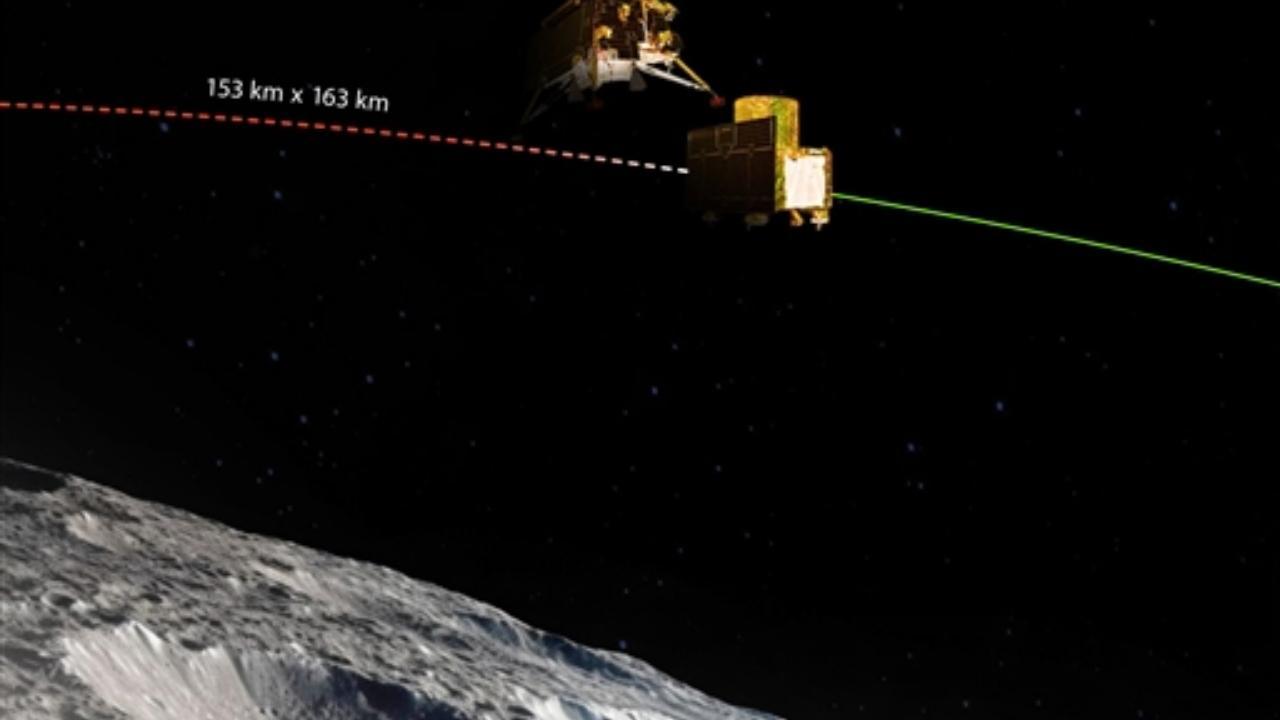Achieving a major milestone, ISRO on Thursday announced that the Chandrayaan-3 spacecraft's Lander Module has successfully separated from the Propulsion module that was propelling it all these days in space

An illustration showing ISRO's 'Chandrayaan-3' after its landing module (LM) successfully separated from the propulsion module (Pic/PTI)
Achieving a major milestone, ISRO on Thursday announced that the Chandrayaan-3 spacecraft's Lander Module has successfully separated from the Propulsion module that was propelling it all these days in space.
ADVERTISEMENT
The Lander Module comprising the lander (Vikram) and the rover (Pragyan) is now ready to be lowered to an orbit that takes it closer to the Moon's surface. The soft landing on the Lunar south pole is scheduled on August 23. "Thanks for the ride, mate! said the Lander Module (LM). LM is successfully separated from the Propulsion Module (PM). LM is set to descend to a slightly lower orbit upon a deboosting planned for tomorrow around 1600 Hrs., IST," ISRO said in a post on X (formerly Twitter).
After Thursday's separation, the lander is expected to undergo a "deboost" (the process of slowing down) to place it in an orbit, where the Perilune (the orbit's closest point to the Moon) is 30 kilometres and Apolune (farthest point from the Moon) is 100 km, from where the soft landing on the south polar region of the Moon will be attempted, ISRO sources said.
Meanwhile, the Propulsion Module will continue its journey in the current orbit for months/years, the country's space agency said.
"The SHAPE (Spectro-polarimetry of Habitable Planet Earth) payload onboard it (Propulsion Module) would perform spectroscopic study of the Earth's atmosphere and measure the variations in polarization from the clouds on Earth ¿ to accumulate signatures of Exoplanets that would qualify for our habitability!" ISRO said, adding that this payload is shaped by its U R Rao Satellite Centre in Bengaluru.
Post its launch on July 14, Chandrayaan-3 entered into the lunar orbit on August 5, following which orbit reduction maneuvers were carried out on the satellite on August 6, 9, 14 and 16, ahead of separation of both its modules today, in the runup to the landing on August 23.
ISRO Chairman S Somanath had recently said the most critical part of the landing is the process of bringing the velocity of the lander from 30 km height to the final landing, and that the ability to transfer the spacecraft from horizontal to vertical direction is the "trick we have to play" here.
"The velocity at the starting of the landing process is almost 1.68 km per second, but this speed is horizontal to the surface of the moon. The Chandrayaan-3 here is tilted almost 90 degrees, it has to become vertical. So, this whole process of turning from horizontal to vertical is a very interesting calculation mathematically.
We have done a lot of simulations. It is here where we had the problem last time (Chandrayaan-2)," Somanath explained.
Earlier, over five moves in the three weeks since the July 14 launch, ISRO had lifted the Chandrayaan-3 spacecraft into orbits farther and farther away from the Earth.
Then, on August 1 in a key maneuver -- a slingshot move -- the spacecraft was sent successfully towards the Moon from Earth's orbit. Following this trans-lunar injection, the Chandrayaan-3 spacecraft escaped from orbiting the Earth and began following a path that would take it to the vicinity of the moon.
Chandrayaan-I Project Director M Annadurai said: "It is a great moment and this will imply how the lander is performing and the lander will be verified and tested and brought closer and closer to the moon.. then it will be given the required commands such that it takes over on the cue on August 23 to go all the way to the targeted place and have a safe and secure landing".
"This is the beginning and all further milestones have to be seen very carefully. We have crossed major milestones from the launch vehicle and after that the propulsion system (separation)...now really the match starts. These are the final overs we are talking about. I think it is a great moment. The whole world is waiting to see what Vikram will do and What Pragyan will come out and do... I am also enthusiastically waiting," Annadurai told PTI.
Chandrayaan-3 is a follow-on mission to Chandrayaan-2 to demonstrate end-to-end capability in safe landing and roving on the lunar surface.
The mission objectives of Chandrayaan-3 are to demonstrate safe and soft landing on the lunar surface, to demonstrate rover roving on the Moon, and to conduct in-situ scientific experiments.
The lander has the capability to soft land at a specified lunar site and deploy the rover that will carry out in-situ chemical analysis of the Moon's surface during the course of its mobility.
The lander and the rover have scientific payloads to carry out experiments on the lunar surface.
This story has been sourced from a third party syndicated feed, agencies. Mid-day accepts no responsibility or liability for its dependability, trustworthiness, reliability and data of the text. Mid-day management/mid-day.com reserves the sole right to alter, delete or remove (without notice) the content in its absolute discretion for any reason whatsoever.
 Subscribe today by clicking the link and stay updated with the latest news!" Click here!
Subscribe today by clicking the link and stay updated with the latest news!" Click here!







